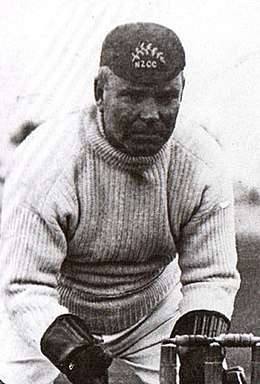Charles Boxshall
Charles Boxshall (7 July 1862 – 13 November 1924) was an Australian-born New Zealand wicket-keeper who played first-class cricket from 1898 to 1915, and played 12 times for New Zealand in the days before New Zealand played Test cricket.
 | |||||||||||||||||||||||||||
| Personal information | |||||||||||||||||||||||||||
|---|---|---|---|---|---|---|---|---|---|---|---|---|---|---|---|---|---|---|---|---|---|---|---|---|---|---|---|
| Full name | Charles Boxshall | ||||||||||||||||||||||||||
| Born | 7 July 1862 Brighton, Victoria, Australia | ||||||||||||||||||||||||||
| Died | 13 November 1924 (aged 62) Balmain, New South Wales, Australia | ||||||||||||||||||||||||||
| Batting | Left-handed | ||||||||||||||||||||||||||
| Role | Wicket-keeper | ||||||||||||||||||||||||||
| Domestic team information | |||||||||||||||||||||||||||
| Years | Team | ||||||||||||||||||||||||||
| 1897-98 to 1914-15 | Canterbury | ||||||||||||||||||||||||||
| Career statistics | |||||||||||||||||||||||||||
| |||||||||||||||||||||||||||
Source: Cricinfo, 19 November 2014 | |||||||||||||||||||||||||||
Early life and career
He was one of the seven sons (and three daughters) of Thomas Boxshall, who was foreman of the Carlton Gardens in Melbourne.[1] He played club cricket in Melbourne before moving to Christchurch in the late 1890s. He made his first-class debut for Canterbury in February 1898 at the age of 35, opening the batting and top-scoring with 25 in his first innings.[2] In two matches in 1898-99 he made six stumpings off five different Canterbury bowlers.
Playing for New Zealand
After those three matches he was selected to tour Australia with the New Zealand team in 1898-99 when Arnold Williams was unavailable.[3] He became the regular New Zealand wicket-keeper, playing in 12 of New Zealand's next 14 matches. His last matches for New Zealand came on the tour of Australia in 1913-14, when at 51 he was still the country's first choice as wicket-keeper. He was replaced later that season, when Australia toured New Zealand, by James Condliffe.
"Short and rotund," said Dick Brittenden, "he wore an ample white moustache, but as a wicket-keeper he was incredibly quick, so quick that there were some who said he could not do what he did and do it legally. A left-hander and a willing hitter, he was always given a tremendous reception when he came out to bat."[4] He often made useful runs in the lower order. In 1902-03, when Lord Hawke's XI thrashed South Island by an innings and 130 runs, Boxshall top-scored in each innings for South Island, with 15 and 40.[5] In 1908-09 against Otago, after Canterbury had lost their first nine wickets for 108, he came in at number 11 and put on 98 for the last wicket with Sydney Orchard.[6] He retired from first-class cricket in March 1915 at the age of 52.[7]
Later life
In New Zealand he ran the Booklovers' Library in Christchurch's Cathedral Square.[8] When he returned to Australia in the early 1920s he lived in Sydney and had business interests in New Guinea oil.[9]
An obituary appreciation in the Christchurch Evening Post said he was "the most brilliant wicket-keeper ever seen in New Zealand, being quite as good as any man who has toured here with overseas teams".[10] In 1936 the New Zealand cricket historian Tom Reese declared that Boxshall was the greatest New Zealand wicket-keeper.[11]
References
- The Australasian, 29 November 1924, p. 33.
- Canterbury v Otago 1897-98
- Don Neely & Richard Payne, Men in White: The History of New Zealand International Cricket, 1894–1985, Moa, Auckland, 1986, p. 40.
- R.T. Brittenden, Great Days in New Zealand Cricket, A.H. & A.W. Reed, Wellington, 1958, p. 35.
- "South Island v Lord Hawke's XI 1902-03". Cricinfo. Retrieved 28 September 2018.
- Otago v Canterbury 1908-09
- "Charles Boxshall Retires". Free Lance: 20. 13 March 1915.
- The Press, 24 November 1924, p. 10.
- The Referee, 3 December 1924, p. 12.
- The Evening Post, 29 November 1924, p. 19.
- "The Best N.Z. Eleven: Mr. T. W. Reese's choice". Press: 3. 3 April 1937.